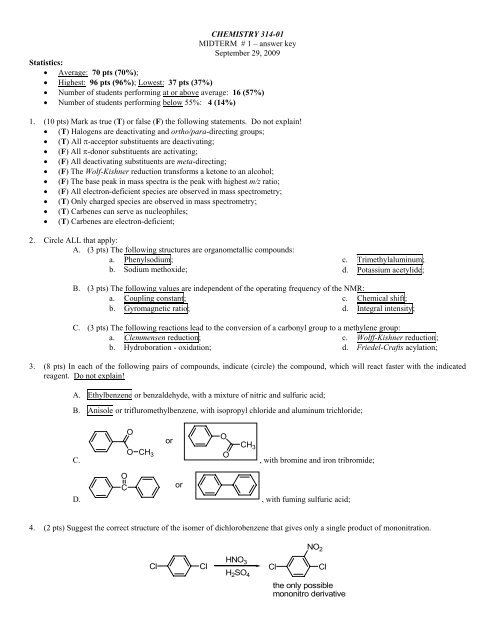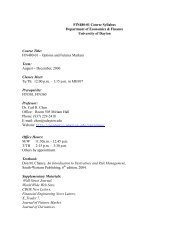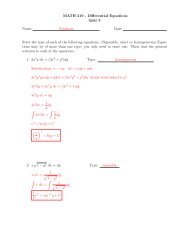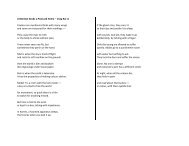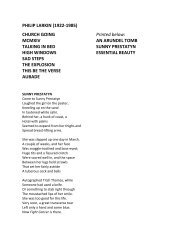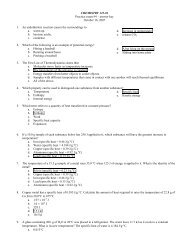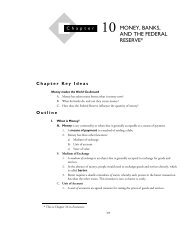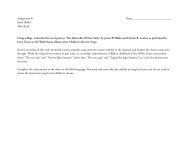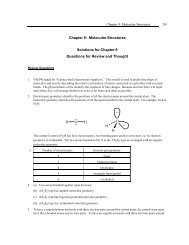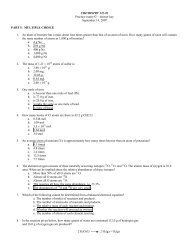CHEMISTRY 314-01 MIDTERM # 1 – answer key September 29 ...
CHEMISTRY 314-01 MIDTERM # 1 – answer key September 29 ...
CHEMISTRY 314-01 MIDTERM # 1 – answer key September 29 ...
Create successful ePaper yourself
Turn your PDF publications into a flip-book with our unique Google optimized e-Paper software.
<strong>CHEMISTRY</strong> <strong>314</strong>-<strong>01</strong><br />
<strong>MIDTERM</strong> # 1 <strong>–</strong> <strong>answer</strong> <strong>key</strong><br />
<strong>September</strong> <strong>29</strong>, 2009<br />
Statistics:<br />
• Average: 70 pts (70%);<br />
• Highest: 96 pts (96%); Lowest: 37 pts (37%)<br />
• Number of students performing at or above average: 16 (57%)<br />
• Number of students performing below 55%: 4 (14%)<br />
1. (10 pts) Mark as true (T) or false (F) the following statements. Do not explain!<br />
• (T) Halogens are deactivating and ortho/para-directing groups;<br />
• (T) All π-acceptor substituents are deactivating;<br />
• (F) All π-donor substituents are activating;<br />
• (F) All deactivating substituents are meta-directing;<br />
• (F) The Wolf-Kishner reduction transforms a ketone to an alcohol;<br />
• (F) The base peak in mass spectra is the peak with highest m/z ratio;<br />
• (F) All electron-deficient species are observed in mass spectrometry;<br />
• (T) Only charged species are observed in mass spectrometry;<br />
• (T) Carbenes can serve as nucleophiles;<br />
• (T) Carbenes are electron-deficient;<br />
2. Circle ALL that apply:<br />
A. (3 pts) The following structures are organometallic compounds:<br />
a. Phenylsodium;<br />
b. Sodium methoxide;<br />
B. (3 pts) The following values are independent of the operating frequency of the NMR:<br />
a. Coupling constant;<br />
b. Gyromagnetic ratio;<br />
c. Trimethylaluminum;<br />
d. Potassium acetylide;<br />
c. Chemical shift;<br />
d. Integral intensity;<br />
C. (3 pts) The following reactions lead to the conversion of a carbonyl group to a methylene group:<br />
a. Clemmensen reduction;<br />
b. Hydroboration - oxidation;<br />
c. Wolff-Kishner reduction;<br />
d. Friedel-Crafts acylation;<br />
3. (8 pts) In each of the following pairs of compounds, indicate (circle) the compound, which will react faster with the indicated<br />
reagent. Do not explain!<br />
A. Ethylbenzene or benzaldehyde, with a mixture of nitric and sulfuric acid;<br />
B. Anisole or trifluromethylbenzene, with isopropyl chloride and aluminum trichloride;<br />
C.<br />
D.<br />
O<br />
C<br />
O<br />
O CH 3<br />
or<br />
or<br />
O<br />
O<br />
CH 3<br />
, with bromine and iron tribromide;<br />
, with fuming sulfuric acid;<br />
4. (2 pts) Suggest the correct structure of the isomer of dichlorobenzene that gives only a single product of mononitration.<br />
Cl Cl<br />
HNO 3<br />
H 2SO 4<br />
NO 2<br />
Cl Cl<br />
the only possible<br />
mononitro derivative
5. (2 pts) Although tropylium bromide is aromatic, it does not undergo any Friedel <strong>–</strong> Crafts reactions. Suggest a brief explanation.<br />
The tropylium cation has an overall positive charge, which would make very difficult<br />
Br<br />
any attachment of electrophile (which is itself positively charged). In other words,<br />
the aromatic ring is severely deactivated. And, as we know, Friedel <strong>–</strong> Crafts<br />
reactions do not occur with deactivated aromatic substances<br />
tropylium bromide<br />
6. Write and complete a chemical equation for each of the following reactions:<br />
A. (3 pts) Furan + bromine, in acetic acid;<br />
O<br />
Br 2<br />
B. (3 pts) Pyridine and sulfuric acid, upon heating;<br />
H2SO4 N<br />
CH 3COOH O<br />
heat<br />
C. (3 pts) Anisole with t-butyl chloride, in the presence of AlCl3;<br />
D. (3 pts) Propyllithium with<br />
E. (3 pts)<br />
O<br />
OCH 3<br />
O<br />
AlCl 3<br />
Cl<br />
N<br />
Br<br />
SO 3H<br />
H , followed by acidification;<br />
O<br />
Li<br />
1)<br />
H<br />
2) H3O +<br />
OH<br />
OCH 3<br />
OCH3 with two equivalents of vinylmagnesium bromide, followed by acidification;<br />
O 1)<br />
MgBr<br />
OH<br />
OCH 3<br />
2<br />
2) H 3O +<br />
7. (14 pts) Indicate the principal organic product of each of the following reactions. If o-,p-mixture is expected, write both<br />
products.<br />
O<br />
Cl<br />
NO 2<br />
H 2SO 4<br />
heat<br />
HNO 3<br />
H 2SO 4<br />
1) CH 3MgI/THF<br />
2) H 3O +<br />
HO<br />
Cl<br />
SO 3H<br />
NO 2<br />
NO 2<br />
H<br />
O<br />
H 3CO OCH 3<br />
Br 2<br />
FeBr 3<br />
O<br />
O O<br />
Br<br />
AlCl 3<br />
H<br />
O<br />
(C 2H 5) 2CuLi<br />
ether<br />
Br<br />
H 3CO OCH 3<br />
O
O<br />
H H2NNH 2NNH 2<br />
KOH , heat<br />
CH2I2, Zn(Cu)<br />
ether<br />
8. (2 pts) Predict the major product of mono-nitration of the following compound:<br />
O<br />
Cl<br />
Cl<br />
OCH 3<br />
HNO 3<br />
H 2SO 4<br />
9. (4 pts) Suggest one example of each of the following (formulas please!):<br />
A. A Grignard reagent.<br />
CH3CH2MgCl<br />
B. A metal carbonyl.<br />
W(CO)6<br />
10. (4 pts) Using specific structures, suggest an example of each of the following:<br />
A. A Clemmensen reduction.<br />
B. Preparation of a lithium dialkylcuprate.<br />
2<br />
O<br />
Li + CuI<br />
Zn (Hg)<br />
HCl<br />
Δ<br />
ether<br />
O<br />
1) HC CNa , liq. NH3 2) H 3O +<br />
OCH 3<br />
CHCl 3<br />
KOH<br />
NO 2<br />
C. A carbene.<br />
O<br />
:C(OCH3)2<br />
HO<br />
Cl Cl<br />
D. A σ-donor, π-acceptor group.<br />
<strong>–</strong> B(OH)2<br />
CuLi + LiI<br />
11. Suggest a detailed synthetic sequence for the preparation of each of the following molecules, starting from the indicated<br />
compound, and using any other necessary reagents.<br />
A. (5 pts) 2-Chloro-4-nitrobenzoic acid, using benzene as a starting material (Assume you can separate o- and pisomers);<br />
Cl<br />
AlCl 3<br />
HNO 3<br />
H 2SO 4<br />
NO 2<br />
Cl 2<br />
FeCl 3<br />
NO 2<br />
Cl<br />
1) KMnO4 water/t-butanol<br />
2) HCl<br />
COOH<br />
Cl<br />
NO 2
B. (5 pts) 1-phenyl-1-ethanol, using benzene as a starting material;<br />
Br 2<br />
Fe<br />
Br<br />
Mg<br />
ether<br />
MgBr<br />
1)<br />
2) H3O +<br />
H3C C H<br />
O OH<br />
12. (4 pts) In presence of acid catalyst benzene undergoes an SEAr reaction with H2O2 to form phenol. Suggest a detailed mechanism<br />
for this conversion.<br />
OH<br />
H2O2 +<br />
O O<br />
H H<br />
H<br />
O O<br />
H H<br />
H 2SO 4<br />
H 3O +<br />
H<br />
O O<br />
H H<br />
OH<br />
H<br />
+ HSO 4<br />
H 2O<br />
OH<br />
+ H 3O +<br />
13. (5 pts) Certain compound has molecular formula C11H12O2. Its 1 H and 13 C NMR spectra are shown below. Propose a structure<br />
for this molecule.<br />
10<br />
9<br />
8<br />
7<br />
6<br />
5<br />
4<br />
3<br />
2<br />
1
200<br />
175<br />
n-propyl group; typical pattern<br />
of triplet (CH 3), multiplet (CH 2)<br />
and triplet (CH 2)<br />
150<br />
125<br />
100<br />
para-disubstituted benzene ring; typical<br />
pattern of two doublets of equal intensity<br />
O O<br />
H<br />
75<br />
50<br />
25<br />
aldehyde H-atom; shifted<br />
far downfiled (9 - 10 ppm)<br />
14. (2 pts) Among the following structures, circle the compound that has one signal in its 1 H NMR and two signals in its 13 C NMR:<br />
O O<br />
F F<br />
H 3C CH 3<br />
15. (2 pts) In class, our NMR discussion started with just the hydrogen nucleus, without any electrons. If you were able to run an 1 H<br />
NMR spectrum of a sample of H-nuclei (e.g. some H + in the gas phase), where would you expect to find the signal:<br />
A. Far downfield, δ > 10 ppm.<br />
B. Within the typical range for hydrogen, 10 > δ > 0 ppm.<br />
C. Far upfield, δ < 0 ppm.<br />
Briefly account for your choice: The H-nucleus is not shielded at all, since there isn’t any electron density around it.<br />
When nuclei are not shielded (or, alternatively, heavily deshielded), then their signals experience considerable downfield<br />
shifts. Thus, one would expect the signal for the H-nucleus to be found far downfield, with chemical shift value δ > 10<br />
ppm.<br />
16. (3 pts) Among the isomeric alkenes C4H8, suggest the structure that would exhibit 4 signals in its 1 H NMR spectrum.<br />
17. (4 pts) In the mass spectrum of 2-methyl-2-pentanol, among other signals, there are two prominent peaks at m/z = 87 and m/z =<br />
59. Suggest structures for the species that are responsible for these signals and the fragmentation that leads to them from the<br />
molecular ion.<br />
Solution: Since the signals are prominent, they must correspond to very typical alcohol fragmentations. It turns out that both<br />
signals in question are generated by the same type of fragmentation: α-cleavage.<br />
+<br />
OH<br />
OH<br />
m/z = 59 m/z = 102<br />
Cl<br />
Cl<br />
OH<br />
m/z = 87<br />
+ CH 3
18. (2 pts) BONUS PROBLEM (In order to receive credit for this problem, it has to be solved entirely!!). The nitroso group (<strong>–</strong><br />
N = O) has a directing and activating effect identical to that of halogens. Account for this by using appropriate resonance<br />
structure analysis.<br />
N O<br />
In order to mimic a halogen, the NO group must have a deactivating, but o-,p-directing effect. The deactivation is a result of both an<br />
inductive and resonance effect:<br />
N<br />
O negative<br />
inductive<br />
effect, - I<br />
N O<br />
N O<br />
N O<br />
negative resonance effect (-R)<br />
The o-,p-orientation is a result of a positive resonance effect (conjugation of N-lone pair with the π-system of the ring):<br />
N O<br />
N O<br />
N O<br />
positive resonance effect (+R)<br />
N O<br />
N O


